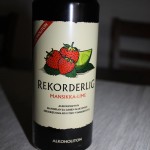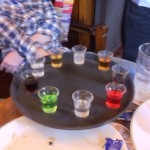At last year’s Edinburgh Science Festival, Richard Wiseman demonstrated that people can’t tell the difference between expensive wine and cheap wine. It was covered in both The Guardian and The Telegraph. In fact, one of the funniest things about the whole business was some of the snobbery from the Guardian’s readers.
“Expensive is when you get to the £50 – £100 plus range. That’s when you really taste the difference.”
“Let’s do this with £2.99 against £299 instead. I think you might find the results aren’t quite the same.”
“£10 is expensive eh?
Pour them a glass of 2000 Domaine de Chevalier Blanc (the besr white I have ever tasted) at £60 a bottle and see if you get the same responses.”“I ‘ve had £100 a bottle wine I CAN TELL THE DIFFERENCE!”
The wine community didn’t seem to appreciate the results. Wine of the Week bolding told his readers that new evidence would be just around the corner.
WineOfTheWeek is aghast at such claims of label snobbery, and will bet his Tommy Hilfiger jeans that contradictory evidence will soon follow.
I presume he meant to say “against”. Unfortunately for him, more than a year on, and the new evidence has still yet to arrive. Wine Anorak did a slightly better job of arguing against, pointing out that members of the public weren’t given two wines to directly compare, but only one, and asked to say whether it was a cheap or expensive one.
Actually, this makes perfect sense though. You never (or at least I never) buy two bottles of wine, do a quick taste test and throw the bad one away. You just buy one bottle of wine (with others perhaps to follow later) and your enjoyment is based solely on that. As Richard himself said, “to keep it as realistic as possible, we presented them with a single glass of wine and they had to say whether inexpensive or expensive”.
Even if you want to poke your nose up at Richard’s experiment, a full paper has been previously published on the topic by the University of Minnesota. Here is what they concluded.
Individuals who are unaware of the price do not derive more enjoyment from more expensive wine. In a sample of more than 6,000 blind tastings, we find that the correlation between price and overall rating is small and negative, suggesting that individuals on average enjoy more expensive wines slightly less. For individuals with wine training, however, we find indications of a positive relationship between price and enjoyment. Our results are robust to the inclusion of individual fixed effects, and are not driven by outliers: when omitting the top and bottom deciles of the price distribution, our qualitative results are strengthened, and the statistical significance is improved further. Our results indicate that both the prices of wines and wine recommendations by experts may be poor guides for non-expert wine consumers.
So there you have it. You can’t tell the difference between an expensive wine and a cheap wine. So you might as well pick up the cheap bottle. Indeed, with the money you’ll save, why not buy two bottles of the cheap stuff, taste them, and throw the least pleasant one away.
Don't have time to check my blog? Get a weekly email with all the new posts. This is my personal blog, so obviously it is 100% spam free.
Tags: alcohol, richard wiseman, snobbery, wine
This entry was posted on Thursday, August 23rd, 2012 at 12:40 pm and is filed under Science. You can follow any responses to this entry through the RSS 2.0 feed. Both comments and pings are currently closed.

